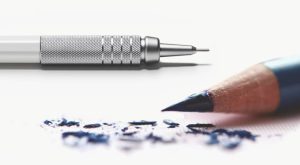Are you tired of constantly breaking pencil leads while sketching Or maybe your hand gets cramped after hours of shading and detailing Look no further, because we’ve got the ultimate guide to help you choose the best mechanical pencil for sketching needs! Whether you’re an aspiring artist or a seasoned pro, this blog post will walk you through everything from lead hardness and grip comfort to durability and precision. Say goodbye to smudged drawings and hello to effortless creativity with our expert tips and recommendations. So grab your sketchbook, because it’s time to find the perfect mechanical pencil that’ll take your artwork to new heights!
Introduction to the best mechanical pencil for sketching
When it comes to sketching, having the right tool can make all the difference. A mechanical pencil is a precision instrument that can help you achieve the level of detail and accuracy you need for your sketches. In this guide, we’ll introduce you to the basics of mechanical pencils and help you choose the best one for your needs.
Mechanical pencils have a long history, dating back to the late 17th century when they were first used for drafting purposes. The modern mechanical pencil was invented in 1822 by Nicholas-Jacques Conte, and it has been an essential tool for artists and engineers ever since.
A mechanical pencil consists of three main parts: the lead holder, the lead, and the eraser. The lead holder is a metal or plastic tube that houses the lead. The lead is a thin strip of graphite that is held in place by a spring-loaded mechanism inside the lead holder. The eraser is located at the end of the pencil, opposite the tip.
When shopping for a mechanical pencil, there are several things to keep in mind. The first is size. Mechanical pencils come in a range of sizes, from very small to large. The size you choose will depend on your personal preferences and what you’ll be using the pencil for. If you need a precision instrument for detailed work, a smaller pencil may be better suited for you. For general sketching and drawing, a larger pencil may be more comfortable to use.

Types of Mechanical Pencils
When it comes to mechanical pencils, there are three main types to choose from: lead holders, propelling pencils, and cartridge pencils.
Lead holders, also known as clutch pencils, are the most popular type of mechanical pencil for sketching. They have a metal body with a chuck that holds the lead in place and a lead advance mechanism that allows you to extend the lead as needed. Lead holders are available in a wide range of sizes and styles, so you can find one that fits your hand and drawing style perfectly.
Propelling pencils are similar to lead holders, but they have a built-in lead advance mechanism that extends the lead automatically as you draw. This can be handy if you prefer not to stop and extend the lead manually, but it does require more frequent refilling. Propelling pencils are also available in a wide range of sizes and styles.
Cartridge pencils are the least common type of mechanical pencil for sketching. They have a plastic body with a cartridge that holds the lead inside. Cartridge pencils typically have no lead advance mechanism, so you’ll need to replace the entire cartridge when the lead runs out.
Factors to Consider When Choosing a Mechanical Pencil for Sketching
When it comes to choosing the best mechanical pencil for sketching, there are a few factors you need to take into account. Please check the following steps:
- The lead size is one of the most important factors to consider. You want to make sure that the pencil you choose has a lead size that is appropriate for the type of sketching you’ll be doing. For example, if you’re going to be doing detailed work, you’ll want to opt for a pencil with a thinner lead.
- The barrel material is also an important consideration. Many people prefer wooden barrels because they provide a more natural grip. However, there are also metal and plastic barrels available. It really comes down to personal preference in this case.
- Another thing to consider is the shape of the eraser. Some people prefer erasers that are round, while others prefer those that are pointed. Again, it’s really a matter of personal preference here.
- You need to decide how much money you’re willing to spend on your mechanical pencil. There are pens available at all different price points, so it’s important to find one that fits your budget.
Keep these factors in mind and you’ll be sure to find the perfect mechanical pencil for your sketching needs!
Tips for Purchasing the Right Mechanical Pencil
When it comes to choosing the right mechanical pencil for sketching, there are a few things you need to take into account. Here are some tips to help you purchase the perfect mechanical pencil for your needs:
- Decide what lead size you need. The lead size will determine how thick or thin your lines will be. If you’re not sure what lead size you need, start with a 2mm lead and go from there.
- Consider the barrel material. The barrel of your mechanical pencil should be made from durable materials such as metal or plastic. Avoid wooden barrels as they can break easily.
- Choose a comfortable grip. The grip is an important factor in determining how comfortable your mechanical pencil will be to use. Make sure to choose a grip that is soft and comfortable to hold.
Reviews of Popular Mechanical Pencils
There are a few key factors you’ll want to consider when choosing a mechanical pencil for sketching. The first is lead size. You’ll want to choose a pencil with a lead that is fine enough for detailed work, but not so fine that it easily breaks. A good rule of thumb is to choose a lead size that is somewhere between 0.5mm and 0.7mm.
Another important factor to consider is the type of lead that the pencil uses. The two most common types of leads are graphite and ceramic. Graphite leads are softer and produce darker lines, while ceramic leads are harder and create lighter lines. Ultimately, the type of lead you choose is a matter of personal preference.
You’ll want to pay attention to the construction of the pencil itself. Look for a pencil that feels comfortable in your hand and has a sturdy build. This will help ensure that your pencil lasts for many years of sketching and drawing.
Now that you know what to look for, let’s take a look at some of the best mechanical pencils for sketching on the market today:
The Pilot Metropolitan Collection Mechanical Pencil is one of the most popular options among artists and sketchers. It features a classic design with a brass barrel and black grip section. The Metropolitan comes with five refillable Pilot Hi-Tec-C refills in 0.5mm, 0.7mm, or 0
Alternatives to Mechanical Pencils
When it comes to sketching, there are a few different pencil types that you can choose from. Mechanical pencils are definitely the most popular option, but there are also wood case pencils and regular wooden pencils. So, which one should you choose?
Well, it really depends on your personal preference. Some people prefer the precision that mechanical pencils offer, while others find wooden pencils to be more natural and comfortable to use. And then there are those who prefer the convenience of wood case pencils – no need to sharpen them constantly!
If you’re still undecided, why not try out all three types and see which one you like best? Or, if you’re looking for some alternatives to mechanical pencils, here are a few options:
- Wood case pencils: These are basically wooden pencils with a metal casing around them. They’re strong and durable, so they won’t break easily in your bag. And because they don’t have any lead inside, they’re very lightweight – perfect for carrying around with you.
- Wooden pencils: These are the traditional type of pencils that most people think of when they hear the word “pencil”. They’re made entirely of wood, so they’re quite sturdy. And because they have a thicker lead inside, they tend to be darker and more intense in color
Conclusion
Sketching with a mechanical pencil can be an incredibly enjoyable and rewarding experience. To make sure you get the most out of your sketching endeavors, it’s important to choose the best mechanical pencil for your individual needs. We hope that this guide has given you all the information you need to make an informed decision when looking for a new sketching tool. No matter what type of artist or sketcher you are, there is a perfect mechanical pencil out there waiting to help bring your artistic vision into reality. If you need any other information please visit this website buscells.com











